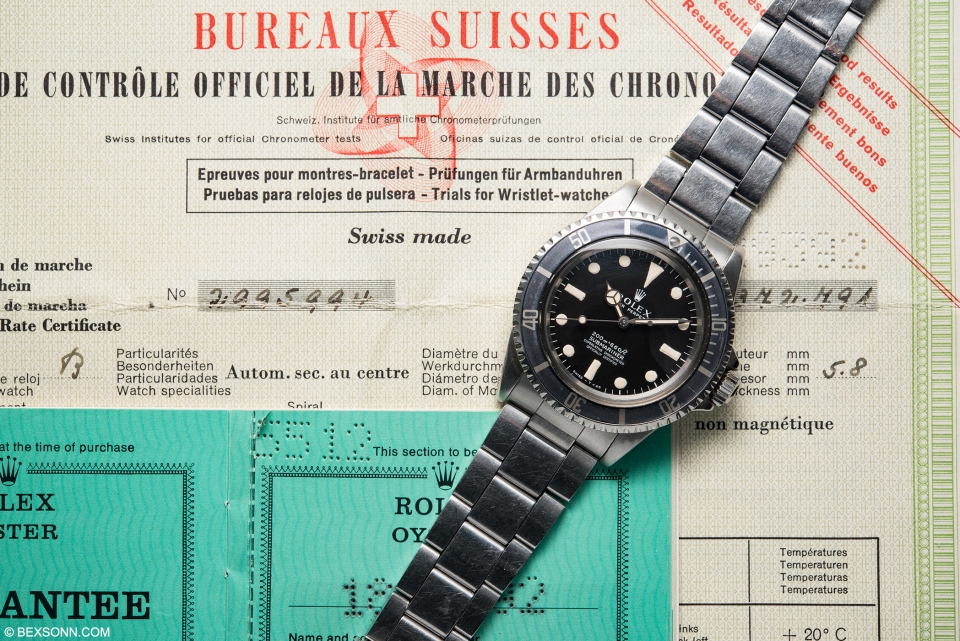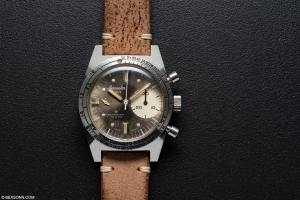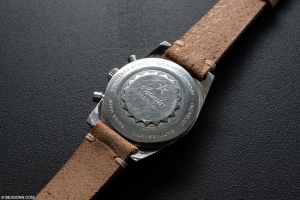Yep that’s right folks, we’re now into March, which means a couple of things for us here at BEXSONN and the wider watch community. 1. BaselWorld 2018 watch fair is upon us and 2. It is Watches of Knightsbridge’s first London auction of the year. We recently spent some time over at 64 Knightsbridge to have a look at a handful of timepieces in the upcoming March auction on the 17th. As per usual we decided to pick out some of our highlighted lots and share our thoughts on them.
AQUASTAR DEEPSTAR
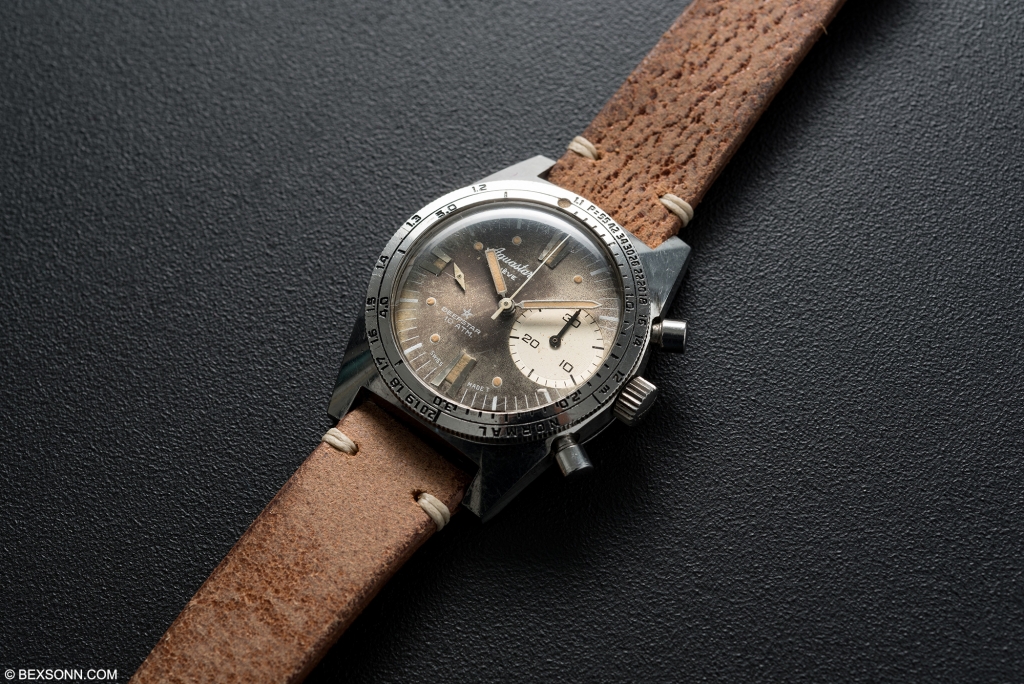 Lot 71: For some reason or another, I’ve come to admire these pieces of late – perhaps it’s the quirkiness of the oversized seconds sub dial, or even maybe its sharp angled case but whatever it is I think these divers’ chronographs are quite something. The Aquastar Deepstar Chronograph was used by the one and only Jacques Cousteau and his crew on the Calypso back in the sixties. It sports and unusual but unique little propeller seconds hand and one of the biggest contrasting subsidiary dials of all vintage watches.
Lot 71: For some reason or another, I’ve come to admire these pieces of late – perhaps it’s the quirkiness of the oversized seconds sub dial, or even maybe its sharp angled case but whatever it is I think these divers’ chronographs are quite something. The Aquastar Deepstar Chronograph was used by the one and only Jacques Cousteau and his crew on the Calypso back in the sixties. It sports and unusual but unique little propeller seconds hand and one of the biggest contrasting subsidiary dials of all vintage watches.
This early piece here is authentic in every single part. Tropical dial and hands appear with original lume and an overwhelming grey-golden patina that brings an awesome individual look to that watch. Crown and the Valjoux 23 movement bridge as well are Aquastar signed. Even turning the Auqastar over, reveals a very cool case back and this one appears to be quite well-preserved. It comes on a brown suede strap which nicely matches the dial patination.
Estimate: £4,000 – £6,000
MULCO ANTIMAGNETIC CHRONOGRAPH
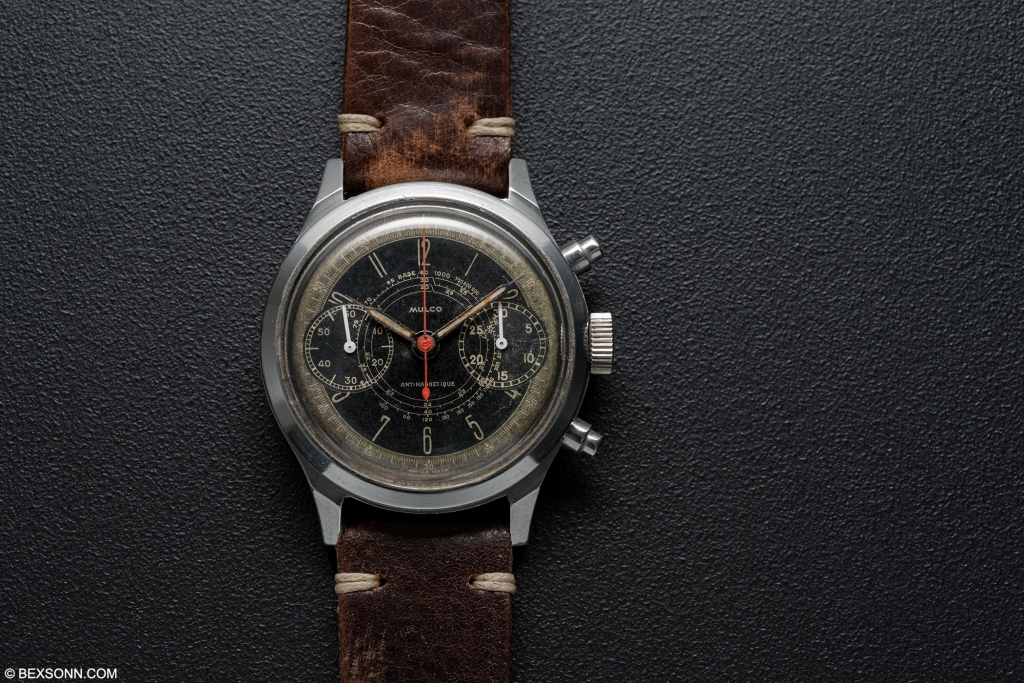 Lot 86: Last year I mentioned that these days I quite drawn to chronographs from the 40s and 50s made by lesser known watch brands and this is one of them. There is a recurring trend as to what the most popular chronographs are today. Multi-scale, check, Two-tone, check and obscurity, check. Large 38mm stainless steel ‘Spillman’ case, check. All this, and more. Looking at the two-tone dial of this Mulco chronograph, it is evident to see it has seen some rather rough days, but all this adds to the allure and patina of the watch itself. While it is relatively easy to find ‘Spillman’ cased chronographs in the vintage market, this particular one has so much more going for it. A closer inspection shows the dial has actually started to change colour, to a tone which can only be described as tropical. Adding further depth to this 40s Mulco chronograph is the inner tach-o-meter scale, with the addition of Arabic numerals too. This Mulco is powered by the common, yet revered Valjoux 22 calibre movement. Overall, the condition, quality and rarity of this watch makes it one of my favourite pieces in the auction – not to mention the attractive estimate.
Lot 86: Last year I mentioned that these days I quite drawn to chronographs from the 40s and 50s made by lesser known watch brands and this is one of them. There is a recurring trend as to what the most popular chronographs are today. Multi-scale, check, Two-tone, check and obscurity, check. Large 38mm stainless steel ‘Spillman’ case, check. All this, and more. Looking at the two-tone dial of this Mulco chronograph, it is evident to see it has seen some rather rough days, but all this adds to the allure and patina of the watch itself. While it is relatively easy to find ‘Spillman’ cased chronographs in the vintage market, this particular one has so much more going for it. A closer inspection shows the dial has actually started to change colour, to a tone which can only be described as tropical. Adding further depth to this 40s Mulco chronograph is the inner tach-o-meter scale, with the addition of Arabic numerals too. This Mulco is powered by the common, yet revered Valjoux 22 calibre movement. Overall, the condition, quality and rarity of this watch makes it one of my favourite pieces in the auction – not to mention the attractive estimate.
Estimate £3,500 – £4,500
OMEGA ‘ED WHITE’ SPEEDMASTER NAAFI
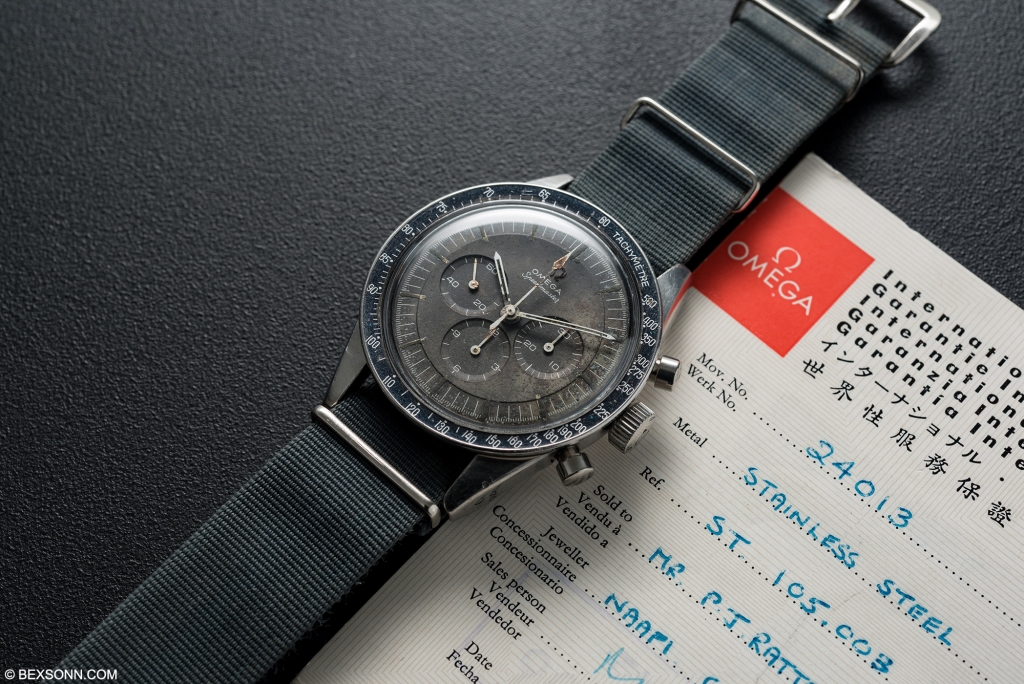 Lot 193: Vintage Omega Speedmasters have come into their own of late, with the straight-lug models of the CK2915, which is right at the top of the pyramid, the CK2998 (aka the Wally Shirra) and then the 105.003, also known as the ‘Ed White’ – which is perhaps more common than the first two mentioned but also more attainable. The reference 105.00 was produced between 1964 and 1969, and it was the watch that superseded all other brands by passing NASA’s rigorous qualification tests in 1965 that resulted in the Omega Speedmaster becoming the official watch used on space missions. The Ed White also marked the last of the straight lug Speedmasters.
Lot 193: Vintage Omega Speedmasters have come into their own of late, with the straight-lug models of the CK2915, which is right at the top of the pyramid, the CK2998 (aka the Wally Shirra) and then the 105.003, also known as the ‘Ed White’ – which is perhaps more common than the first two mentioned but also more attainable. The reference 105.00 was produced between 1964 and 1969, and it was the watch that superseded all other brands by passing NASA’s rigorous qualification tests in 1965 that resulted in the Omega Speedmaster becoming the official watch used on space missions. The Ed White also marked the last of the straight lug Speedmasters.
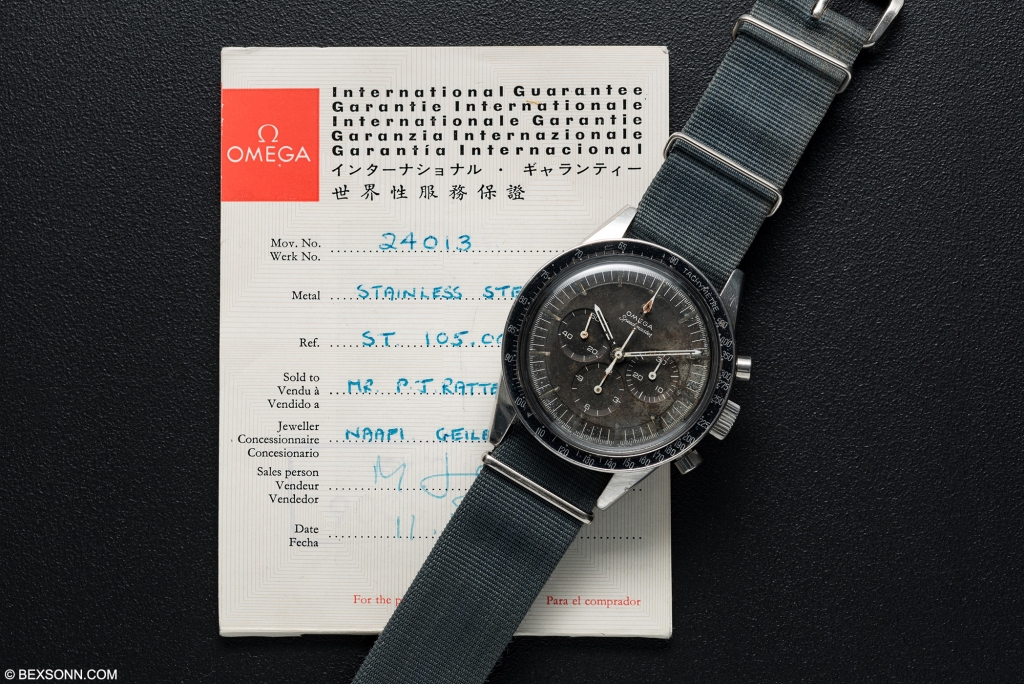 However, with all due respect, we haven’t just highlighted any old Ed White. Speedmasters were of course issued to NASA’s astronauts but this particular example was purchased from the British Military suppliers NAAFI Geilenkirchen (an establishment created by the British Government back in 1921 to sell goods to servicemen and their families) – perhaps the reason it looks like it has seen some rather tough days but again, as mentioned above, this all adds to its patina and of course its story. The dial is well weathered and looks almost tropical but still remains honest. The case appears to be in quite good condition despite the weathered dial and it fittingly comes on a NATO strap.
However, with all due respect, we haven’t just highlighted any old Ed White. Speedmasters were of course issued to NASA’s astronauts but this particular example was purchased from the British Military suppliers NAAFI Geilenkirchen (an establishment created by the British Government back in 1921 to sell goods to servicemen and their families) – perhaps the reason it looks like it has seen some rather tough days but again, as mentioned above, this all adds to its patina and of course its story. The dial is well weathered and looks almost tropical but still remains honest. The case appears to be in quite good condition despite the weathered dial and it fittingly comes on a NATO strap.
Estimate: £6,000 – £8,000
ROLEX SUBMARINER REF. 5512
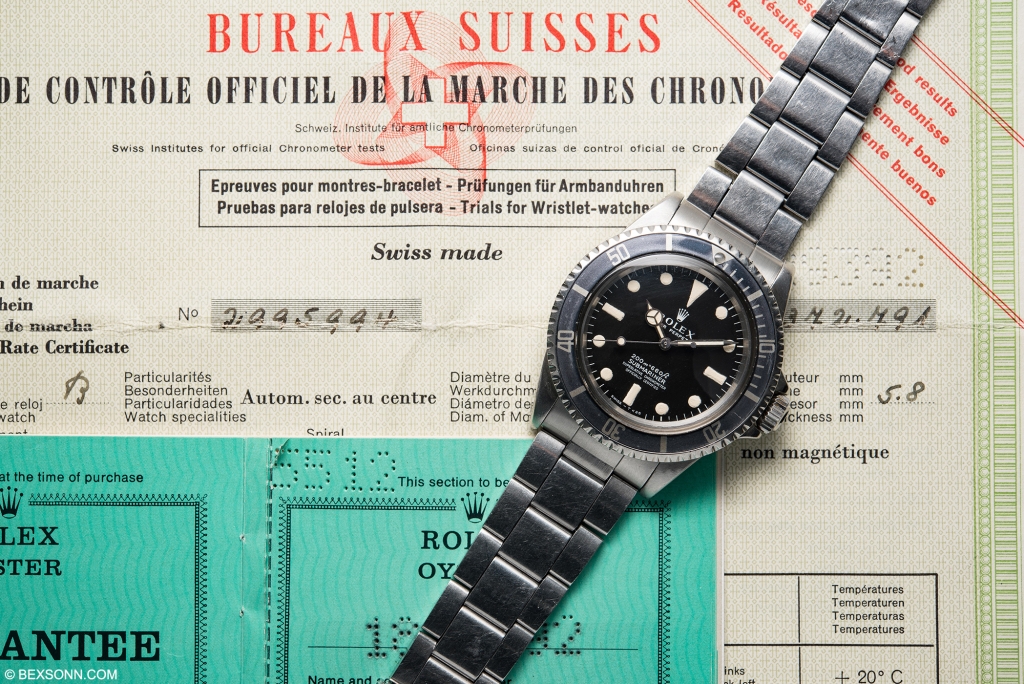 Lot 267: There is no denying that the Submariner is the ultimate tool watch and we have highlighted quite a few variations here. But there’s nothing like showing our readers a humble and modest 5512, albeit, with a few sought-after details that make collecting Rolex timepieces so intriguing. I’m always told it’s the finer details that make Rolex timepieces interesting and this one has a 4-liner, with metres first depth rating and there’s more – it comes with box, papers and chronometer test certificate. While this is more of a novelty – as these cannot be worn – it does add some weight to its overall value. This Submariner 5512 features a black matte dial with applied luminous markers. Inside is the 26-jewelled calibre 1570 movement signed Rolex SA and dated IV.67 (4th quarter of 1967). However, the case back is correctly stamped 5513.
Lot 267: There is no denying that the Submariner is the ultimate tool watch and we have highlighted quite a few variations here. But there’s nothing like showing our readers a humble and modest 5512, albeit, with a few sought-after details that make collecting Rolex timepieces so intriguing. I’m always told it’s the finer details that make Rolex timepieces interesting and this one has a 4-liner, with metres first depth rating and there’s more – it comes with box, papers and chronometer test certificate. While this is more of a novelty – as these cannot be worn – it does add some weight to its overall value. This Submariner 5512 features a black matte dial with applied luminous markers. Inside is the 26-jewelled calibre 1570 movement signed Rolex SA and dated IV.67 (4th quarter of 1967). However, the case back is correctly stamped 5513.
Estimate: £12,000 – £15,000
ROLEX GMT-MASTER REF. 1675
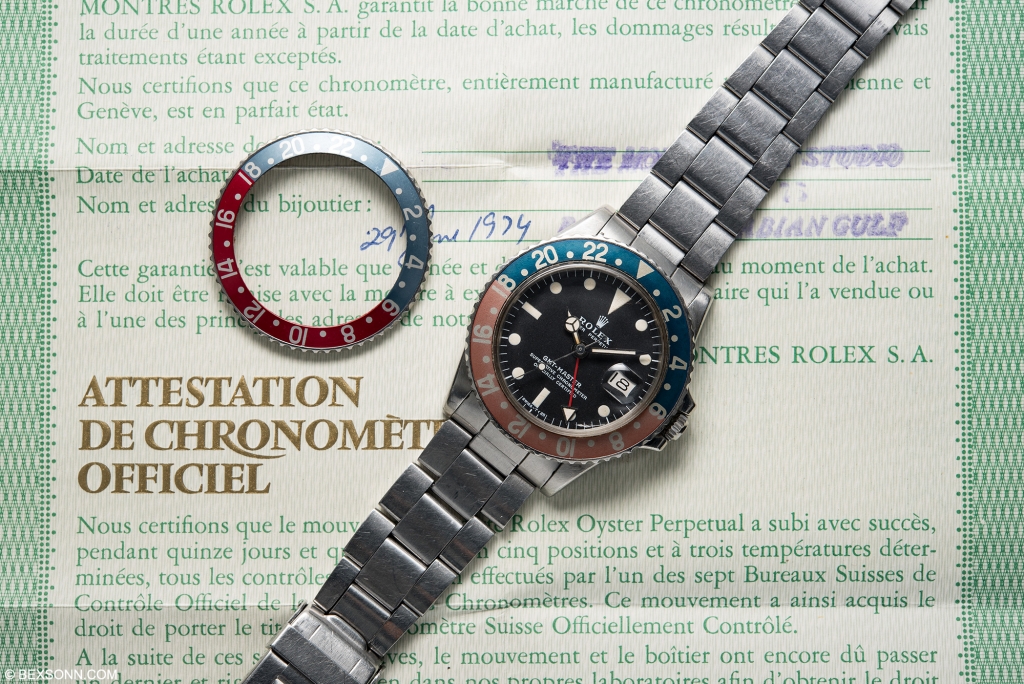 Lot 271: I’ve said it before and I’ll say it again, the Rolex GMT-Master is, arguably, more likeable than the Submariner. Why? Perhaps the actual everyday usefulness is much more appreciated and there is also the point of, when you have a GMT, you just kind of have a GMT; not to say there aren’t subtle differences between them but each one just seems to be appreciated for what it is. This example is in great, honest, condition with natural signs of ageing and comes complete with all the original box and papers, booklets, as well as additional bezel insert and has been consigned to the auction by the original owner. This 1971 Rolex GMT-Master reference 1675 features a matte black dial, with luminous markers and customary Mercedes hands. Inside is the automatic calibre 1570, signed Rolex S.A. and dated II.71. The Oyster case measures approximately 40mm with its signature “fat font” 24-hour “Pepsi” rotating bezel.
Lot 271: I’ve said it before and I’ll say it again, the Rolex GMT-Master is, arguably, more likeable than the Submariner. Why? Perhaps the actual everyday usefulness is much more appreciated and there is also the point of, when you have a GMT, you just kind of have a GMT; not to say there aren’t subtle differences between them but each one just seems to be appreciated for what it is. This example is in great, honest, condition with natural signs of ageing and comes complete with all the original box and papers, booklets, as well as additional bezel insert and has been consigned to the auction by the original owner. This 1971 Rolex GMT-Master reference 1675 features a matte black dial, with luminous markers and customary Mercedes hands. Inside is the automatic calibre 1570, signed Rolex S.A. and dated II.71. The Oyster case measures approximately 40mm with its signature “fat font” 24-hour “Pepsi” rotating bezel.
Estimate: £9,000 – £12,000
ROLEX OYSTER PERPETUAL REF. 6084
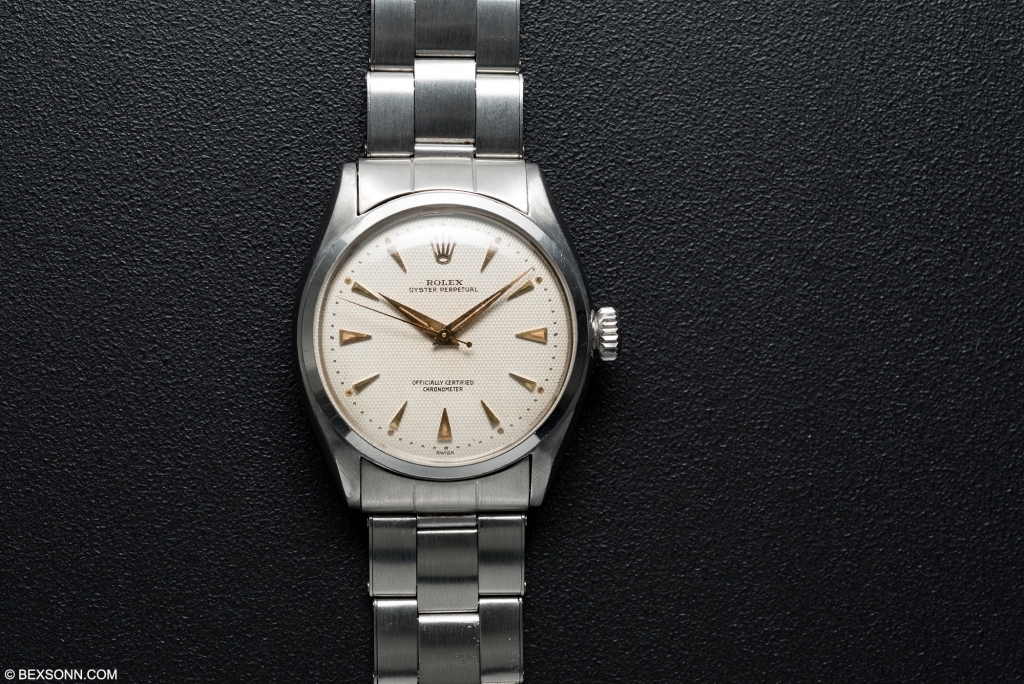 Lot 315: You are probably used to me showcasing timepieces from Rolex sports range of watches, such as the pieces already mentioned above. That said, this little watch caught my eye – it’s just so clean aesthetically. Easily one of the most elegant Rolex watches I’ve seen in a little while. This reference 6084 features a beautiful honeycomb dial, something often seen on the Milgauss ref. 6541 watches from the late 1950s. The reference 6084 is the transitional piece from the “Bubbleback” era that preceded the Datejusts and Day-Dates that came after. The reference 6084 featured the traditional Rolex Oyster style case and though it only measured a mere 34mm in size, the cleanness of the dial makes it appear a tad larger. However, the allure of this 6084 is all in the amazing honeycomb dial; the pattern just draws you in. It features applied arrow markers, with the markers at 3,6 and 9 o’clock being inlaid with luminous material and comes on a riveted Oyster bracelet.
Lot 315: You are probably used to me showcasing timepieces from Rolex sports range of watches, such as the pieces already mentioned above. That said, this little watch caught my eye – it’s just so clean aesthetically. Easily one of the most elegant Rolex watches I’ve seen in a little while. This reference 6084 features a beautiful honeycomb dial, something often seen on the Milgauss ref. 6541 watches from the late 1950s. The reference 6084 is the transitional piece from the “Bubbleback” era that preceded the Datejusts and Day-Dates that came after. The reference 6084 featured the traditional Rolex Oyster style case and though it only measured a mere 34mm in size, the cleanness of the dial makes it appear a tad larger. However, the allure of this 6084 is all in the amazing honeycomb dial; the pattern just draws you in. It features applied arrow markers, with the markers at 3,6 and 9 o’clock being inlaid with luminous material and comes on a riveted Oyster bracelet.
ROLEX REF. 6098 ‘OVETTONE’
 Lot 318: There is just something about vintage Rolex pieces from the 1950s and this particular example embodies the crossover between the old bubblebacks and the newer sports models. The 6098 is considered to be the prototype for the Explorer model and there are even examples signed Explorer too, which are believed to be very rare. The Rolex Oyster Perpetual ref. 6098, one of those rare timepieces that were part of “history in the making” as it was on May 29, 1953 that Sir Edmund Hillary successfully reached the peak of Mount Everest – his mighty and faithful stainless-steel Rolex reference 6098 strapped on his wrist. At the time, its 36mm case diameter, the famed Rolex “Ovettone” was the largest bubbleback-type, time-only watch produced by the brand. This 1952 example features a matte white dial, which has patinated to a warm creamy tone, inset gilt block and baton markers with 12, 6 numerals, inset coronet, gilt feuille hands. Inside beats the automatic calibre 775, however the case back bears the ref. 6028 but is dated IV.52 (4th quarter of 1952).
Lot 318: There is just something about vintage Rolex pieces from the 1950s and this particular example embodies the crossover between the old bubblebacks and the newer sports models. The 6098 is considered to be the prototype for the Explorer model and there are even examples signed Explorer too, which are believed to be very rare. The Rolex Oyster Perpetual ref. 6098, one of those rare timepieces that were part of “history in the making” as it was on May 29, 1953 that Sir Edmund Hillary successfully reached the peak of Mount Everest – his mighty and faithful stainless-steel Rolex reference 6098 strapped on his wrist. At the time, its 36mm case diameter, the famed Rolex “Ovettone” was the largest bubbleback-type, time-only watch produced by the brand. This 1952 example features a matte white dial, which has patinated to a warm creamy tone, inset gilt block and baton markers with 12, 6 numerals, inset coronet, gilt feuille hands. Inside beats the automatic calibre 775, however the case back bears the ref. 6028 but is dated IV.52 (4th quarter of 1952).
Estimate: £2,000 – £3,000
ROLEX OYSTER PRINCE BRANCARD REF. 971
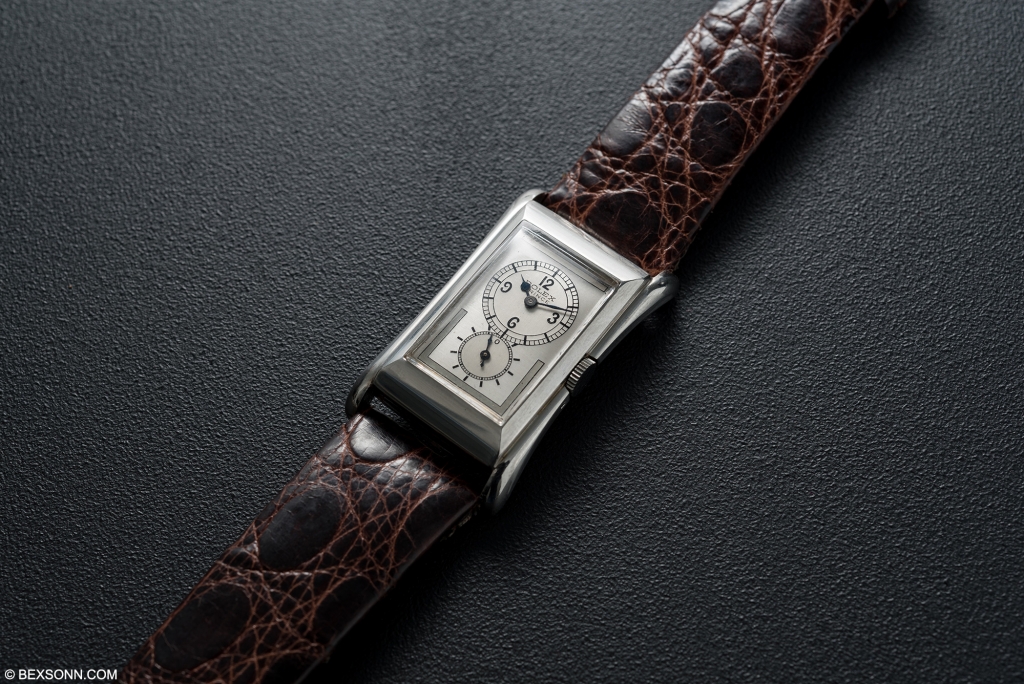 Lot 333: Released in 1928, the Rolex Prince, or “Doctor’s Watch”, was an incredibly accurate wristwatch. Often fitted with a chronometer movement, the model featured a subsidiary seconds register below the hours and minutes section of the dial, enabling a doctor to time pulses and respiration, hence the other name it was known by. Rolex took full advantage of this concept during the period, marketing the watch to professionals in the medical industry. The watch absolutely captures the zeitgeist of the 1920s, with its elegant, stepped case and deco-style dial composition. Prince watches generally feature two different case styles: the soft, curved model with flared sides, such as the present watch, is known as the Brancard. The sharp, angled and rectangular model, is known as the Classic. While Prince watches were cased in a variety of metals, such as 9K gold or white gold, the rarest, most exclusive and valuable examples were available in platinum – such as this example. This ref. 971 features a well-preserved silver dial that nicely contrasts with heavy platinum case, which measures 43mm x 26mm. The upper hour and minutes dial features a sector style layout with numerals at 3, 6, 9 and 12, which just adds to the overall look. As many of you may know, it is notoriously difficult to handle platinum and only the most skilled artisans could work with the metal, further enhancing this examples exclusivity.
Lot 333: Released in 1928, the Rolex Prince, or “Doctor’s Watch”, was an incredibly accurate wristwatch. Often fitted with a chronometer movement, the model featured a subsidiary seconds register below the hours and minutes section of the dial, enabling a doctor to time pulses and respiration, hence the other name it was known by. Rolex took full advantage of this concept during the period, marketing the watch to professionals in the medical industry. The watch absolutely captures the zeitgeist of the 1920s, with its elegant, stepped case and deco-style dial composition. Prince watches generally feature two different case styles: the soft, curved model with flared sides, such as the present watch, is known as the Brancard. The sharp, angled and rectangular model, is known as the Classic. While Prince watches were cased in a variety of metals, such as 9K gold or white gold, the rarest, most exclusive and valuable examples were available in platinum – such as this example. This ref. 971 features a well-preserved silver dial that nicely contrasts with heavy platinum case, which measures 43mm x 26mm. The upper hour and minutes dial features a sector style layout with numerals at 3, 6, 9 and 12, which just adds to the overall look. As many of you may know, it is notoriously difficult to handle platinum and only the most skilled artisans could work with the metal, further enhancing this examples exclusivity.
VACHERON CONSTANTIN REF. 4301
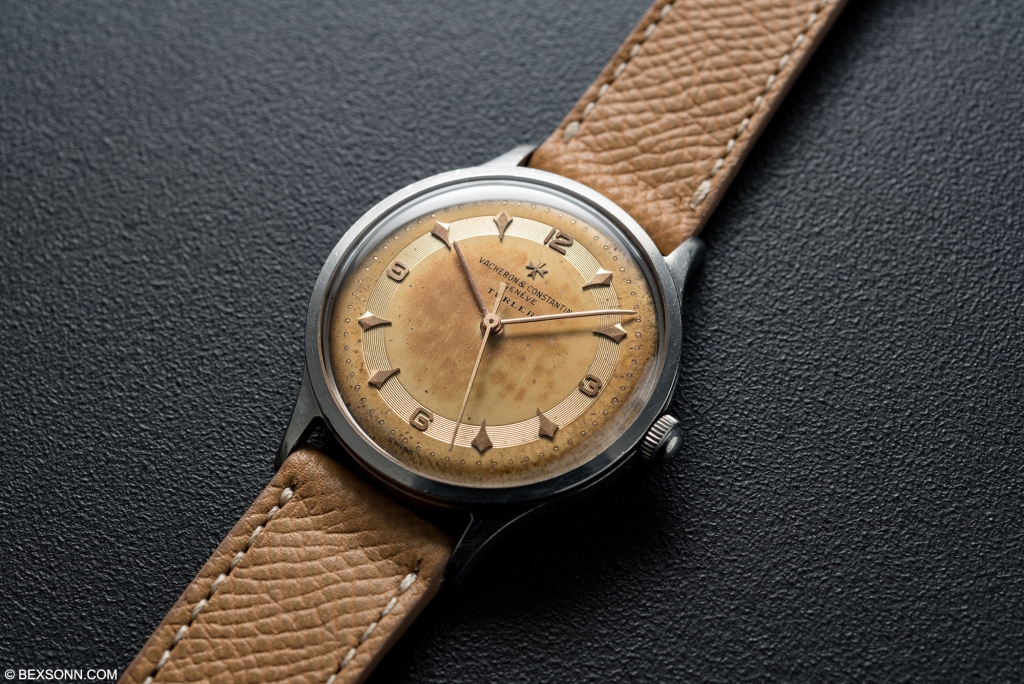 Lot 334: Last but certainly not least is this Vacheron Constantin. Why have I highlighted this piece? Well, one reason and one reason only, it’s made from rare metal and I’m not talking about white gold or platinum but stainless steel. Any Vacheron Collector will tell you that finding a time only VC in stainless steel is an extremely rare thing and this my dear readers is just that. You may have heard me wax lyrical in the past about just how rare finding pieces made by the likes of AP, Patek or Vacheron from the 40s or 50s are. That is because when it came to these haute horlogerie brands producing dress watches during these years they always tended to use gold or to an extent platinum because steel was considered inferior. But when any of these 3 watch brands decide to make a watch in stainless steel, not many are made making them seriously rare.
Lot 334: Last but certainly not least is this Vacheron Constantin. Why have I highlighted this piece? Well, one reason and one reason only, it’s made from rare metal and I’m not talking about white gold or platinum but stainless steel. Any Vacheron Collector will tell you that finding a time only VC in stainless steel is an extremely rare thing and this my dear readers is just that. You may have heard me wax lyrical in the past about just how rare finding pieces made by the likes of AP, Patek or Vacheron from the 40s or 50s are. That is because when it came to these haute horlogerie brands producing dress watches during these years they always tended to use gold or to an extent platinum because steel was considered inferior. But when any of these 3 watch brands decide to make a watch in stainless steel, not many are made making them seriously rare.
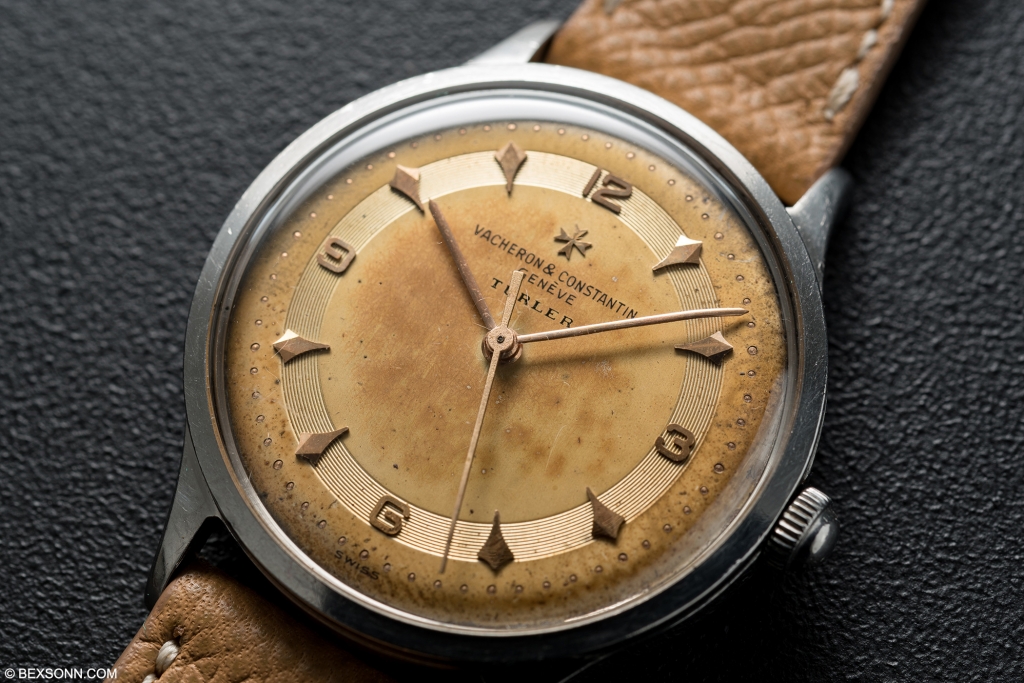 Moreover, this is no ordinary stainless-steel vintage VC dress watch, no. It’s 35 mm case features a waterproof screw down case back and yet there is more. You’ll notice the dial bears another name. This example has been signed Zurich retailer Türler. The case on this piece has been well-preserved with, of course, signs of aging. The once silver two-tone dial has turned to a warm bronze hue, almost matching the gold indices and hands. Inside beats the renowned calibre 454 manual-wound movement, built from a Jaeger-LeCoultre ébauche.
Moreover, this is no ordinary stainless-steel vintage VC dress watch, no. It’s 35 mm case features a waterproof screw down case back and yet there is more. You’ll notice the dial bears another name. This example has been signed Zurich retailer Türler. The case on this piece has been well-preserved with, of course, signs of aging. The once silver two-tone dial has turned to a warm bronze hue, almost matching the gold indices and hands. Inside beats the renowned calibre 454 manual-wound movement, built from a Jaeger-LeCoultre ébauche.
Estimate: £3,000 – £4,000
The Watches of Knightsbridge auction will take place on the 17th March 2018, make sure you visit the official website for this month’s full catalogue.
